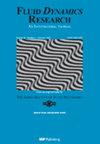球体绕其直径垂直于两个有滑动面的平面的缓慢旋转
IF 1.3
4区 工程技术
Q3 MECHANICS
引用次数: 4
摘要
分析了不可压缩牛顿流体绕垂直于一个或两个滑移面壁上旋转的滑移球形颗粒的稳态蠕动流动。为了满足流体速度的Stokes方程,通解由球坐标和柱坐标下的基本解和组成。首先通过汉克尔变换在平面壁面上实现边界条件,然后通过配点法在粒子表面实现边界条件。对相关几何参数和粘滑参数的不同取值,得到了施加在颗粒上的流体动力扭矩,具有很好的收敛性,并且滑移面对滑动颗粒旋转运动的影响是有趣的。从完全滑移的极限到无滑移的极限,扭矩随壁面粘性的增加而增加。当平面壁面黏附参数大于某一临界值时,流体动力扭矩大于无界流体中相同颗粒的流体动力扭矩,并且是颗粒表面黏附度和颗粒半径与壁面距离之比的递增函数。反之,当平面壁面粘滞参数小于临界值时,扭矩小于无界流体中颗粒的扭矩,并且是表面粘滞度和颗粒相对半径的递减函数。本文章由计算机程序翻译,如有差异,请以英文原文为准。
Slow rotation of a sphere about its diameter normal to two planes with slip surfaces
The steady creeping flow of an incompressible Newtonian fluid around a slip spherical particle rotating about its diameter perpendicular to one or two slip plane walls is analyzed. To satisfy the Stokes equation for fluid velocity, the general solution consists of the sum of the essential solutions in spherical and cylindrical coordinates. Boundary conditions are implemented first on the plane walls by means of the Hankel transforms and then on the particle surface through a collocation method. The hydrodynamic torque exerted on the particle is obtained with excellent convergence for various values of the pertinent geometrical and stick-slip parameters, and the effect of the slip planes on the rotational motion of the slip particle is interesting. The torque increases with an increase in the stickiness of the walls from the limit of full slip to the limit of no slip. When the stick parameters of the plane walls are larger than some critical values, the hydrodynamic torque is more than that on an identical particle in the unbounded fluid and an increasing function of the stickiness of the particle surface and ratio of the particle radius to distance from the walls. When the stick parameters of the plane walls are smaller than the critical values, on the contrary, the torque is less than that on the particle in the unbounded fluid and a decreasing function of the surface stickiness and relative radius of the particle.
求助全文
通过发布文献求助,成功后即可免费获取论文全文。
去求助
来源期刊

Fluid Dynamics Research
物理-力学
CiteScore
2.90
自引率
6.70%
发文量
37
审稿时长
5 months
期刊介绍:
Fluid Dynamics Research publishes original and creative works in all fields of fluid dynamics. The scope includes theoretical, numerical and experimental studies that contribute to the fundamental understanding and/or application of fluid phenomena.
 求助内容:
求助内容: 应助结果提醒方式:
应助结果提醒方式:


